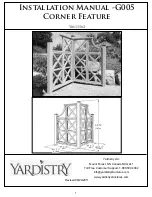
45
Safe Handling of Gas Cylinders
Handling Cylinders
•
If it becomes necessary to move cylinders, do so with a suitable hand truck
after ensuring that the container cap is secured and the cylinder properly
fastened to the hand truck.
•
Use only gas-pressure regulators, tubing, and hose connectors approved by an
appropriate regulatory agency.
•
Arrange gas hoses where they will not be damaged or stepped on, and where
objects will not be dropped on them.
•
Do
not
refill gas cylinders.
•
Check the condition of pipes, hoses, and connectors regularly. Perform gas
leak tests at all joints and seals of the gas system regularly, using an approved
gas leak detection solution.
•
When the equipment is turned off, close all gas cylinder valves tightly at the
cylinder. Bleed the remainder of the line before turning the exhaust vent off.
Hazardous Chemicals Warnings
Before using any chemicals or solvents with the instrument, the customer should
be thoroughly familiar with all hazards and safety handling practices. Observe the
manufacturer’s recommendations for use, storage and disposal. These
recommendations are normally supplied in the material safety data sheets (MSDS)
supplied with the solvents.
Some chemicals used with this instrument may be hazardous or may
become hazardous after completing an analysis.
The responsible body
(e.g. Lab Manager) must take the necessary precautions to ensure that the
surrounding workplace and the instrument operators are not exposed to
hazardous levels of toxic substances (chemical or biological) as defined
in the applicable Material Safety Data Sheets (MSDS) or OSHA, ACGIH,
or COSHH documents. Venting for fumes and disposal of waste must be
in accordance with all national, state, and local health and safety
regulations and laws.
!
Warning
Summary of Contents for AVIO 500
Page 1: ...AVIO 500 Customer Hardware and Service Guide ICP OPTICAL EMISSION ...
Page 2: ......
Page 3: ...Avio 500 Customer Hardware and Service Guide ...
Page 12: ...Contents 10 ...
Page 30: ...28 ...
Page 31: ...C h a p t e r 1 ...
Page 32: ......
Page 33: ...Safety Practices 1 ...
Page 58: ...56 Safety Practices ...
Page 59: ...C h a p t e r 2 ...
Page 60: ......
Page 76: ...74 Preparing Your Laboratory ...
Page 77: ...C h a p t e r 3 ...
Page 78: ......
Page 79: ...System Description 3 ...
Page 115: ...C h a p t e r 4 ...
Page 116: ......
Page 137: ...135 Installing the Quick Change Adjustable Torch Module 1 2 10 8 9 3 4 7 6 5 ...
Page 152: ...150 Installation Figure 4 22 Scott Spray Chamber Clip Assembly in Place ...
Page 195: ...193 Shipping Lists 09290798 USB Cable Table 4 6 Spares Available Continued ...
Page 196: ...194 Installation ...
Page 197: ...C h a p t e r 5 ...
Page 198: ......
Page 217: ...215 Quick Change Adjustable Torch Module 1 2 10 8 9 3 4 7 6 5 ...
Page 316: ...314 Maintenance ...
Page 317: ...C h a p t e r 6 ...
Page 318: ......
Page 342: ...340 Troubleshooting Figure 6 5 Injector too far forward ...
Page 344: ...342 Troubleshooting Figure 6 7 Air leak or spray chamber temperature too high ...
Page 346: ...344 Troubleshooting ...
Page 354: ......
















































